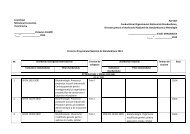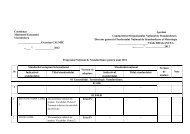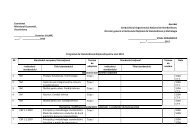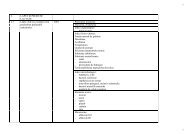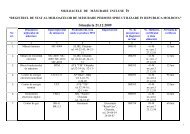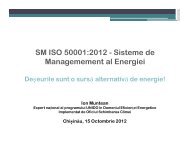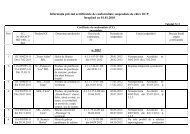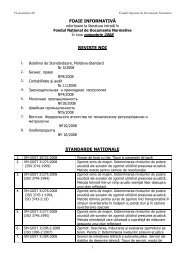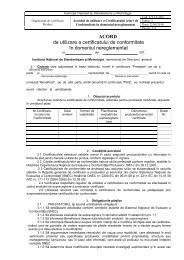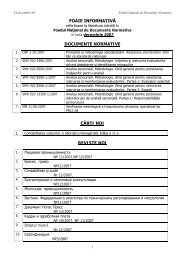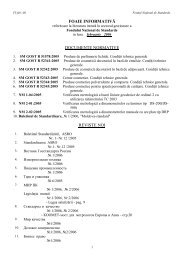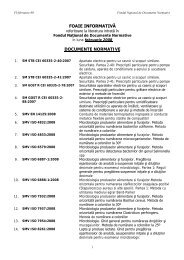3 Guidelines for Establishing a Mentoring Programme within the ...
3 Guidelines for Establishing a Mentoring Programme within the ...
3 Guidelines for Establishing a Mentoring Programme within the ...
Create successful ePaper yourself
Turn your PDF publications into a flip-book with our unique Google optimized e-Paper software.
<strong>Guidelines</strong> <strong>for</strong> <strong>Establishing</strong><br />
a <strong>Mentoring</strong> <strong>Programme</strong> <strong>within</strong><br />
<strong>the</strong> Framework of <strong>the</strong><br />
IEC Young Professionals<br />
<strong>Programme</strong><br />
<strong>Establishing</strong> a <strong>Mentoring</strong> <strong>Programme</strong> <strong>within</strong> <strong>the</strong> Framework of <strong>the</strong> IEC Young Professionals <strong>Programme</strong>
Contents<br />
Introduction .............................................................................................................................................. 3<br />
What is <strong>Mentoring</strong>? .................................................................................................................................. 3<br />
Why is <strong>Mentoring</strong> Important to Achieving <strong>the</strong> Outcomes of <strong>the</strong> IEC Young Professionals<br />
<strong>Programme</strong> ………………………………………………………..….……………………...……………….….. 3<br />
What Makes a Successful <strong>Mentoring</strong> <strong>Programme</strong> .................................................................................. 4<br />
Planning and Design ............................................................................................................................... 6<br />
Planning .................................................................................................................................................. 6<br />
Design ..................................................................................................................................................... 7<br />
Participants, <strong>the</strong>ir roles and responsibilities .......................................................................................... 10<br />
IEC National Committee ................................................................................................................... 10<br />
Facilitator .......................................................................................................................................... 11<br />
Mentor .............................................................................................................................................. 11<br />
Mentee ............................................................................................................................................. 12<br />
Training ............................................................................................................................................ 12<br />
The <strong>Mentoring</strong> Relationship .................................................................................................................. 13<br />
Matching Mentors to Mentees .......................................................................................................... 13<br />
The <strong>Mentoring</strong> Relationship ............................................................................................................. 15<br />
The <strong>Mentoring</strong> Process ........................................................................................................................ 16<br />
Evaluation and Review ......................................................................................................................... 19<br />
Facilitating Ongoing Opportunities ....................................................................................................... 20<br />
Resources ............................................................................................................................................ 21<br />
<strong>Establishing</strong> a <strong>Mentoring</strong> <strong>Programme</strong> <strong>within</strong> <strong>the</strong> Framework of <strong>the</strong> IEC Young Professionals <strong>Programme</strong>
Introduction<br />
<strong>Mentoring</strong> was identified by several participants in <strong>the</strong> 2011 IEC Young<br />
Professionals Workshop as being one tool that would help <strong>the</strong>m to<br />
become involved, or more involved in IEC work.<br />
These guidelines are intended to provide a framework <strong>for</strong> a Young<br />
Professionals <strong>Mentoring</strong> <strong>Programme</strong> that can be used by IEC National<br />
Committees to establish a mentoring programme in <strong>the</strong>ir countries<br />
<strong>within</strong> <strong>the</strong> broader context of <strong>the</strong> IEC Young Professionals <strong>Programme</strong>.<br />
This material is not intended to be prescriptive, but ra<strong>the</strong>r a guidance<br />
document which will provide National Committees with <strong>the</strong> tools and<br />
resources to implement <strong>the</strong>ir own tailored programme. It aims to<br />
encourage National Committees to implement local programmes that<br />
increase <strong>the</strong> participation of young professionals in both national<br />
committees and IEC technical committees with <strong>the</strong> intention of<br />
improving <strong>the</strong> transfer of technologies and experiences.<br />
What is <strong>Mentoring</strong>?<br />
<strong>Mentoring</strong> provides an in<strong>for</strong>mal pathway to developing and<br />
streng<strong>the</strong>ning a Young Professional‟s career in standardization or<br />
con<strong>for</strong>mity assessment. <strong>Mentoring</strong> has many varied definitions;<br />
however in <strong>the</strong> context of <strong>the</strong> IEC, it may be best defined as a<br />
developmental partnership through which one person shares<br />
knowledge, skills, in<strong>for</strong>mation and perspective to foster <strong>the</strong> personal<br />
and professional growth of someone else: a one-of-a-kind opportunity<br />
<strong>for</strong> collaboration, goal achievement and problem-solving [1].<br />
In its best <strong>for</strong>m, mentoring provides benefits to both <strong>the</strong> mentor and <strong>the</strong><br />
mentee.<br />
Why is <strong>Mentoring</strong> Important to Achieving<br />
<strong>the</strong> Outcomes of <strong>the</strong> IEC Young<br />
Professionals <strong>Programme</strong><br />
The mentor can experience enhanced self-esteem, better fulfilment of<br />
<strong>the</strong>ir own developmental needs and industry recognition. As a bonus,<br />
<strong>the</strong> relationship may bring exposure to new ideas, o<strong>the</strong>r perspectives<br />
and intellectual stimulation. The mentee may also „upwardly mentor‟<br />
<strong>the</strong>ir mentor, <strong>for</strong> instance in using new technology.<br />
3 <strong>Guidelines</strong> <strong>for</strong> <strong>Establishing</strong> a <strong>Mentoring</strong> <strong>Programme</strong> <strong>within</strong> <strong>the</strong> Framework of <strong>the</strong> IEC Young Professionals <strong>Programme</strong>
The mentee gets support in fur<strong>the</strong>ring <strong>the</strong>ir involvement <strong>within</strong> <strong>the</strong><br />
IEC community.<br />
Benefits should include access to an in<strong>for</strong>med second opinion, gaining<br />
insight into <strong>the</strong>ir own per<strong>for</strong>mance through a „critical friend‟, identifying<br />
personal development needs and opportunities as well as learning from<br />
<strong>the</strong> experience of <strong>the</strong> mentor.<br />
The IEC National Committees and <strong>the</strong> overall IEC community in turn<br />
will benefit through <strong>the</strong> development of future experts and leaders, and<br />
from <strong>the</strong> transfer of knowledge from experienced to new participants.<br />
<strong>Mentoring</strong> is effective because humans learn through conversation in a<br />
social context, which is <strong>the</strong> essence of mentoring. [2]<br />
What Makes a Successful <strong>Mentoring</strong> <strong>Programme</strong><br />
A successful mentoring programme relies on commitment from a strong<br />
and passionate facilitator who identifies and matches eager mentors<br />
and mentees whose objectives are in line with <strong>the</strong> established goals of<br />
<strong>the</strong> programme.<br />
Whilst <strong>the</strong> following are no guarantee of success, without <strong>the</strong>se key<br />
success factors it is likely <strong>the</strong> programme will not achieve <strong>the</strong> desired<br />
outcomes:<br />
1. Defined objectives and support from <strong>the</strong> leadership of <strong>the</strong><br />
IEC National Committee.<br />
a. Goals should be SMART – specific, measurable,<br />
attainable, relevant and time-bound.<br />
i. E.g. The goal of <strong>the</strong> IEC Young Professionals<br />
<strong>Mentoring</strong> <strong>Programme</strong> is to increase participation<br />
rates in <strong>the</strong> early 20s to mid-30s age group by<br />
X% in X years.<br />
b. A senior leader <strong>within</strong> <strong>the</strong> IEC NC who strongly believes<br />
in <strong>the</strong> programme should be identified and willing to<br />
serve as its champion and advocate.<br />
2. Select a strong and passionate programme facilitator:<br />
a. Successful mentoring programmes are not only<br />
comprised of mentors and mentees – <strong>the</strong>y are managed<br />
by a third party that establishes, designs, plans,<br />
resources, promotes and administers <strong>the</strong> programme,<br />
identifies and matches mentors and mentees, provides<br />
<strong>the</strong>m with training and support and evaluates <strong>the</strong><br />
outcomes.<br />
b. This facilitator may be a committee or an individual from<br />
<strong>the</strong> National Committee.<br />
4 <strong>Guidelines</strong> <strong>for</strong> <strong>Establishing</strong> a <strong>Mentoring</strong> <strong>Programme</strong> <strong>within</strong> <strong>the</strong> Framework of <strong>the</strong> IEC Young Professionals <strong>Programme</strong>
3. Clearly define <strong>the</strong> roles, responsibilities, and limits to<br />
expectations <strong>for</strong> all stakeholders.<br />
4. Make sure all participants and stakeholders are involved<br />
voluntarily.<br />
5. Ensure flexibility is designed into <strong>the</strong> programme:<br />
a. Whilst mentoring is an educational experience, its merits<br />
lie in its in<strong>for</strong>mality and commitment to <strong>the</strong> needs of <strong>the</strong><br />
individual.<br />
b. If a programme is too <strong>for</strong>mal, and structures too rigid, <strong>the</strong><br />
preferred learning methods and outcomes sought by <strong>the</strong><br />
individual will not be met.<br />
6. Promote <strong>the</strong> programme:<br />
a. Promotion is essential to attracting participants (both<br />
mentors and mentees) to <strong>the</strong> programme.<br />
b. Effectively communicate <strong>the</strong> benefits and strategic value<br />
to all stakeholders.<br />
7. Consider <strong>the</strong> needs of <strong>the</strong> mentors and well as <strong>the</strong> mentees:<br />
a. <strong>Establishing</strong> a strong and reliable group of mentors that<br />
remain in <strong>the</strong> programme <strong>for</strong> <strong>the</strong> long term is critical,<br />
o<strong>the</strong>rwise recruiting and training mentors will drain <strong>the</strong><br />
programme‟s resources.<br />
b. Mentors are typically busy professionals with limited time<br />
so <strong>the</strong> time <strong>the</strong>y devote to <strong>the</strong> programme must be<br />
effectively utilized.<br />
c. Recognition and reward strategies, which could include<br />
<strong>for</strong>mal certification as a mentor, could aid in attracting<br />
and retaining quality mentors.<br />
8. Training and preparation are essential <strong>for</strong> both <strong>the</strong> mentors<br />
and mentees:<br />
a. All participants need to be fully aware of <strong>the</strong><br />
programme‟s goals, <strong>the</strong>ir roles, best practices and <strong>the</strong><br />
IEC NC‟s mentoring process.<br />
b. Mentors should receive <strong>for</strong>mal training and ongoing<br />
support.<br />
c. An orientation session at <strong>the</strong> commencement of <strong>the</strong><br />
programme, followed by guidance throughout is one<br />
option.<br />
d. Mentors and Mentees should write down <strong>the</strong>ir objectives<br />
<strong>for</strong> participating and track <strong>the</strong>ir progress against <strong>the</strong>se.<br />
9. Match mentors to mentees<br />
a. The relationship between <strong>the</strong> mentor and <strong>the</strong> mentee is<br />
at <strong>the</strong> core of any mentoring programme.<br />
b. This match-making process should consider <strong>the</strong> mentees<br />
learning needs, field of interest and personality.<br />
c. Ensure <strong>the</strong>re is a process <strong>for</strong> a fault-free re-assignment<br />
of matches in <strong>the</strong> case of mismatches.<br />
10. Have a plan in place <strong>for</strong> managing conflicts of interest<br />
5 <strong>Guidelines</strong> <strong>for</strong> <strong>Establishing</strong> a <strong>Mentoring</strong> <strong>Programme</strong> <strong>within</strong> <strong>the</strong> Framework of <strong>the</strong> IEC Young Professionals <strong>Programme</strong>
11. Establish mentoring metrics<br />
a. Metrics should be established during <strong>the</strong> design of <strong>the</strong><br />
programme around each of its objectives so that <strong>the</strong><br />
progress of <strong>the</strong> programme can be effectively tracked.<br />
12. Set an end date<br />
a. A closure point should be established <strong>for</strong> each mentoring<br />
relationship with milestones established and monitored<br />
<strong>for</strong> set points throughout it.<br />
b. There should be a <strong>for</strong>mal process <strong>for</strong> ending <strong>the</strong><br />
mentoring experience.<br />
13. Provide ongoing opportunities<br />
a. After <strong>the</strong> mentoring process, <strong>the</strong> mentee‟s participation in<br />
standardization may need to be facilitated by <strong>the</strong> National<br />
Committee.<br />
b. Without ensuring that mentees have been put into<br />
contact with relevant technical committees, and that <strong>the</strong>y<br />
have <strong>the</strong> opportunity to practice what <strong>the</strong>y have learnt,<br />
<strong>the</strong> experience will have been in vain.<br />
14. Recognize successes<br />
a. Identify, communicate and recognize individual and<br />
programme-wide successes.<br />
b. This applies to both mentors and mentees.<br />
Planning and Design<br />
Planning<br />
The IEC National Committee should establish a committee, consisting<br />
of potential participants and o<strong>the</strong>r stakeholders, to identify <strong>the</strong> level of<br />
support <strong>for</strong> <strong>the</strong> programme <strong>within</strong> <strong>the</strong>ir organization, <strong>the</strong> risks involved<br />
and potential outcomes. This planning should entail:<br />
1. Verification of <strong>the</strong> needs of young professionals at a national<br />
level and <strong>the</strong> viability of mentoring as a solution to <strong>the</strong>se needs.<br />
2. Confirmation of enthusiasm <strong>for</strong> a mentoring programme – if<br />
<strong>the</strong>re is no enthusiasm <strong>for</strong> mentoring, training or o<strong>the</strong>r options<br />
may be more viable.<br />
3. Identification of mentees – who is <strong>the</strong> target and how can <strong>the</strong><br />
programme meet <strong>the</strong>ir needs?<br />
4. Identification of mentors – identify key areas of experience,<br />
competence and attitude both as a professional and as a person<br />
who should meet potential mentee needs and <strong>the</strong> programme<br />
objectives. Is <strong>the</strong>re an adequate pool of experienced candidates<br />
who are willing to invest <strong>the</strong>ir own time into mentoring young<br />
professionals?<br />
5. Confirmation that <strong>the</strong> IEC National Committee will provide<br />
adequate resources <strong>for</strong> <strong>the</strong> programme, which may include<br />
financing training, providing staff and meeting spaces.<br />
6 <strong>Guidelines</strong> <strong>for</strong> <strong>Establishing</strong> a <strong>Mentoring</strong> <strong>Programme</strong> <strong>within</strong> <strong>the</strong> Framework of <strong>the</strong> IEC Young Professionals <strong>Programme</strong>
6. Identification of who will design and develop <strong>the</strong> programme<br />
– this should include a variety of stakeholders including potential<br />
mentors and mentees.<br />
7. Who will act as <strong>the</strong> programme facilitator, responsible <strong>for</strong><br />
communication, recruitment, training, support and evaluation?<br />
This may be an individual or a group.<br />
8. Consideration of logistical issues including:<br />
a. Start dates<br />
b. Time required to develop <strong>the</strong> programme<br />
c. Lead-time <strong>for</strong> marketing <strong>the</strong> programme<br />
d. Resources required<br />
e. Training and support events necessary.<br />
9. Identification of measurement metrics including establishment<br />
of baseline data. Metrics should include qualitative and<br />
quantitative measurements.<br />
10. Establishment of marketing plan – establish a communication<br />
strategy including above <strong>the</strong> line and below <strong>the</strong> line marketing.<br />
11. Drawing up a budget <strong>for</strong> <strong>the</strong> programme. Possible costs would<br />
include:<br />
a. Capital investments:<br />
i. Preparation<br />
ii. <strong>Programme</strong> design<br />
iii. Publicity materials<br />
iv. Infrastructure: meeting rooms or<br />
teleconferencing/web conferencing facilities.<br />
b. Recurrent costs:<br />
i. Coordination & support<br />
ii. Ongoing publicity<br />
iii. Training<br />
iv. Networking and o<strong>the</strong>r events linked to programme<br />
v. Evaluation & programme amendments.<br />
Design<br />
If <strong>the</strong> planning phase does not identify any insurmountable barriers to<br />
establishing <strong>the</strong> mentoring programme, <strong>the</strong> next task is to design <strong>the</strong><br />
programme. The design committee should consider:<br />
1. What are <strong>the</strong> specific objectives of <strong>the</strong> programme?<br />
2. Will previously defined mentoring best practice, or standards be<br />
followed: <strong>for</strong> example <strong>the</strong> International Standards <strong>for</strong> <strong>Mentoring</strong><br />
<strong>Programme</strong>s in Employment.<br />
3. How will an ethical framework be established <strong>for</strong> <strong>the</strong><br />
<strong>Programme</strong>? Guidance may be sought by referring to<br />
mentoring standards. How this ethical framework will be<br />
communicated and en<strong>for</strong>ced will also need to be considered.<br />
4. What are <strong>the</strong> mentoring metrics and how will outcomes be<br />
evaluated?<br />
7 <strong>Guidelines</strong> <strong>for</strong> <strong>Establishing</strong> a <strong>Mentoring</strong> <strong>Programme</strong> <strong>within</strong> <strong>the</strong> Framework of <strong>the</strong> IEC Young Professionals <strong>Programme</strong>
5. Who will participate and how many? This may need to be reexamined<br />
after <strong>the</strong> availability of suitable and willing mentors is<br />
determined.<br />
6. What level of <strong>for</strong>mality is desired? Remember <strong>the</strong>re needs to<br />
be some flexibility. More administrative control will lead to few<br />
participants. Complete in<strong>for</strong>mality may leave participants without<br />
adequate support and programme goals unmet.<br />
7. What sort of mentoring model is appropriate? The mentoring<br />
programme may recommend one model only, or a combination<br />
of <strong>the</strong> following: one to one, senior-junior, peer to peer, juniorsenior,<br />
group or panel. The selection of mentoring model must<br />
consider which experiential differences are most appropriate in<br />
light of mentee needs and programme goals. These guidelines<br />
deal predominately with <strong>the</strong> one to one, senior-junior model, but<br />
can be applied to o<strong>the</strong>r models.<br />
8. Characteristics and skills needed in <strong>the</strong> mentor? The specific<br />
experience sought in a mentor depends on <strong>the</strong> aims of <strong>the</strong><br />
programme and <strong>the</strong> needs of <strong>the</strong> mentees. O<strong>the</strong>r important<br />
characteristics are:<br />
a. Listening with empathy<br />
b. Sharing experience and learning<br />
c. Being a sounding board<br />
d. Providing professional friendship<br />
e. Developing insight through reflection<br />
f. Being interested in <strong>the</strong> development of o<strong>the</strong>rs.<br />
9. What individual goals are appropriate <strong>for</strong> mentees? These<br />
should be used at briefings and in o<strong>the</strong>r programme in<strong>for</strong>mation.<br />
As individual ideas on what mentoring is and can do vary a lot,<br />
managing expectations from <strong>the</strong> start is crucial.<br />
10. How will participants be recruited, including both mentees<br />
and mentors?<br />
a. Some options include calling <strong>for</strong> nominations and<br />
personal applications.<br />
b. Consideration should also be given to how people will be<br />
persuaded to join.<br />
11. How will applicants be screened and matched?<br />
a. Leave some choice available to both mentor and mentee<br />
in deciding partnerships.<br />
b. Make sure <strong>the</strong>y know how to end <strong>the</strong> relationship without<br />
blame if <strong>the</strong> match doesn‟t work.<br />
c. <strong>Mentoring</strong> software could be considered as <strong>the</strong>re are<br />
several suites such as Chronus that have been<br />
specifically designed <strong>for</strong> this purpose.<br />
d. Consider potential conflicts of interest in <strong>the</strong> matching<br />
process and how <strong>the</strong>se can be managed. Management<br />
techniques can include:<br />
i. Place participants from industry with those from<br />
outside industry (e.g. academia/consumer<br />
protection) and vice versa.<br />
8 <strong>Guidelines</strong> <strong>for</strong> <strong>Establishing</strong> a <strong>Mentoring</strong> <strong>Programme</strong> <strong>within</strong> <strong>the</strong> Framework of <strong>the</strong> IEC Young Professionals <strong>Programme</strong>
ii. Place participants with those from non-competitor<br />
companies.<br />
iii. Have agreements in place from <strong>the</strong> participant‟s<br />
employers that <strong>the</strong>y can engage in a mentoring<br />
relationship with someone from outside <strong>the</strong>ir<br />
company.<br />
iv. Have strong confidentiality policies in place,<br />
which are understood and agreed to by<br />
participants.<br />
v. Market <strong>the</strong> benefits of participating to employers.<br />
12. How will equity and <strong>the</strong> perception of equality be managed<br />
in <strong>the</strong> matching process?<br />
a. <strong>Mentoring</strong> partnerships may cut across gender, culture,<br />
language, disability and/or generation as well as<br />
experience which can lead to difficulties arising.<br />
b. Some points to bear in mind:<br />
i. Cross-gender relationships can provoke gossip if<br />
not handled openly or may be culturally<br />
inappropriate in some countries.<br />
ii. People often feel more at ease with mentoring<br />
partners of <strong>the</strong> same sex and culture.<br />
iii. Partners who differ in one or more of <strong>the</strong>se<br />
characteristics may be unable to provide <strong>the</strong><br />
exchange sought by <strong>the</strong>ir partner, because<br />
priorities and experience are too far apart.<br />
iv. When <strong>the</strong>re is little equality or equity, dependency<br />
may arise – whereby a mentee feels dependent<br />
on <strong>the</strong> mentor <strong>for</strong> <strong>the</strong> future of <strong>the</strong>ir career. This<br />
needs to be avoided wherever possible.<br />
c. Differences in experience and perspective also offer<br />
positive outcomes such as providing insights not<br />
o<strong>the</strong>rwise obtainable.<br />
d. Trying to match participants too closely may result in<br />
<strong>the</strong>re being few mentoring partnerships.<br />
13. What procedures will be put into place to handle relationships<br />
that do not function as intended?<br />
a. For example, arrange that mentoring partners meet with<br />
or give feedback to <strong>the</strong> facilitator after <strong>the</strong>ir first or<br />
second meeting to confirm that <strong>the</strong> partnership feels<br />
positive and that learning goals have been agreed.<br />
b. If <strong>the</strong>re are signs <strong>the</strong> relationship is not functioning as<br />
desired, <strong>the</strong> facilitator should propose and arrange<br />
meetings with alternative partners emphasising that<br />
personal fit is a priority <strong>for</strong> all involved.<br />
14. What orientation and training will be provided to participants?<br />
The following should be considered:<br />
a. Introduction to mentoring in<strong>for</strong>mation pack<br />
b. Orientation presentation<br />
c. Training on how to benefit from mentoring <strong>for</strong> both<br />
mentors and mentees.<br />
9 <strong>Guidelines</strong> <strong>for</strong> <strong>Establishing</strong> a <strong>Mentoring</strong> <strong>Programme</strong> <strong>within</strong> <strong>the</strong> Framework of <strong>the</strong> IEC Young Professionals <strong>Programme</strong>
15. How will participants be supported? This could include:<br />
a. In<strong>for</strong>mal networking opportunities<br />
b. Formal sessions where a particular group can get<br />
toge<strong>the</strong>r to discuss common issues and possible<br />
solutions.<br />
c. Fur<strong>the</strong>r training and <strong>for</strong>mal recognition.<br />
16. What is <strong>the</strong> communication strategy? This could encompass:<br />
a. Encouraging everyone involved to spread <strong>the</strong> word,<br />
which could include via social marketing methods such<br />
as Facebook/LinkedIn.<br />
b. Traditional marketing such as flyers and advertisements.<br />
c. Letters to employers associated with <strong>the</strong> National<br />
Committee.<br />
d. Letters to existing technical committee members.<br />
e. Pre-programme orientations and progress events.<br />
Participants, <strong>the</strong>ir roles and responsibilities<br />
<strong>Mentoring</strong> relationships should be based on trust, acknowledgment of<br />
mutual benefit and a balanced responsibility <strong>for</strong> conduct with attention<br />
to <strong>the</strong> confidential nature of <strong>the</strong> relationship. [3]<br />
IEC National<br />
Committee<br />
Facilitator<br />
Mentor<br />
Mentee<br />
•Strategy<br />
•Promotes<br />
•Resources<br />
•Supports<br />
•Supervizes<br />
•Monitors<br />
•Shares<br />
•Solves<br />
•Motivates<br />
•Explores<br />
•Applies<br />
•Progresses<br />
IEC National<br />
Committee<br />
• Develops a mentoring policy and strategy.<br />
• Communicates this to all stakeholders.<br />
• Promotes mentoring at every opportunity.<br />
• Cultivates a mentoring culture.<br />
• Participates in programme events.<br />
• Members of <strong>the</strong> National Committee may volunteer as<br />
mentors.<br />
10 <strong>Guidelines</strong> <strong>for</strong> <strong>Establishing</strong> a <strong>Mentoring</strong> <strong>Programme</strong> <strong>within</strong> <strong>the</strong> Framework of <strong>the</strong> IEC Young Professionals <strong>Programme</strong>
• Provides <strong>the</strong> resources to plan, design and implement <strong>the</strong><br />
programme.<br />
• Supports <strong>the</strong> facilitator, providing ideas and suggestions<br />
where necessary.<br />
• Participates in <strong>the</strong> monitoring and review of <strong>the</strong> programme.<br />
Facilitator<br />
• Markets <strong>the</strong> programme to involve new mentors and<br />
mentees.<br />
• Processes applications from mentors and mentees to be<br />
involved in <strong>the</strong> programme.<br />
• Provides training and o<strong>the</strong>r support events.<br />
• Facilitates <strong>the</strong> matching of mentors to mentees.<br />
• Arbitrates conflict between mentee and mentor.<br />
• Supervises participants.<br />
• Ensures all participants remain focussed on <strong>the</strong> programme<br />
objectives and adhere to set standards, ethics and<br />
boundaries.<br />
• Monitors and reviews progress of programme, and whe<strong>the</strong>r<br />
goals are being achieved.<br />
• Provides feedback on <strong>the</strong> programme to <strong>the</strong> IEC National<br />
Committee. Ensures mentees have <strong>the</strong> opportunity <strong>for</strong><br />
fur<strong>the</strong>r development following completion of <strong>the</strong> mentoring<br />
relationship.<br />
Mentor<br />
A mentor facilitates personal and professional growth in an individual by<br />
sharing <strong>the</strong> knowledge and insights that have been learned through <strong>the</strong><br />
years. [4] [3]<br />
They are a:<br />
<br />
Teacher – who shares <strong>the</strong>ir knowledge and experience as a<br />
current or <strong>for</strong>mer participant in IEC activities and encourages<br />
<strong>the</strong> mentee in <strong>the</strong>ir learning journey.<br />
• Problem solver – providing solutions to <strong>the</strong> mentee‟s<br />
issues, but more importantly enabling mentees to gain<br />
confidence in analysing and solving problems and become<br />
effective decision-makers.<br />
• Motivator – supporting mentees in discovering, defining and<br />
actioning <strong>the</strong>ir goals <strong>within</strong> <strong>the</strong> scope of <strong>the</strong> programme.<br />
• Listener – who provides an open and non-judgemental<br />
space <strong>for</strong> mentees to discuss <strong>the</strong>ir issues, and after listening<br />
provides encouragement and support in resolving <strong>the</strong>m. The<br />
mentor listens, clarifies, reflects back and, when necessary,<br />
challenges what <strong>the</strong> mentee says.<br />
• Guide – Assisting <strong>the</strong> mentee to reflect on <strong>the</strong>ir beliefs,<br />
thoughts, feelings and behaviours and to view issues from a<br />
number of perspectives.<br />
Mentors need to be able to [3]:<br />
• Commit time to <strong>the</strong>ir mentee<br />
• Be accessible<br />
11 <strong>Guidelines</strong> <strong>for</strong> <strong>Establishing</strong> a <strong>Mentoring</strong> <strong>Programme</strong> <strong>within</strong> <strong>the</strong> Framework of <strong>the</strong> IEC Young Professionals <strong>Programme</strong>
• Be a positive influence<br />
• Give and receive constructive and honest feedback<br />
• Be non-judgemental<br />
• Respect confidences.<br />
A mentor is not <strong>the</strong> manager or director of <strong>the</strong> mentoring relationship.<br />
They should not be <strong>the</strong> mentee‟s direct supervisor or manager in <strong>the</strong>ir<br />
working environment ei<strong>the</strong>r.<br />
Mentee<br />
A mentee is an achiever – "groomed" <strong>for</strong> advancement by being<br />
provided opportunities to excel beyond <strong>the</strong>ir current limits. [4]<br />
They are a:<br />
• Learner – with a strong desire to learn new skills and<br />
abilities.<br />
• Decision maker – taking charge of <strong>the</strong>ir career path <strong>within</strong><br />
<strong>the</strong> IEC, and learning to find <strong>the</strong>ir own solutions.<br />
• Initiator – a mentee is willing to explore challenges on <strong>the</strong>ir<br />
own initiative. The mentee initiates meetings with <strong>the</strong> mentor,<br />
manages meeting dates and times and sets <strong>the</strong> agenda <strong>for</strong><br />
<strong>the</strong> relationship <strong>within</strong> <strong>the</strong> scope of <strong>the</strong> programme.<br />
• Risk taker – “If you want to increase your success rate,<br />
double your failure rate,” said Thomas Watson, Senior,<br />
founder of IBM. A mentee needs to be open to and<br />
appreciate different perspectives and ideas. They cannot be<br />
afraid of learning or changing.<br />
• Communicator – <strong>the</strong> mentee must be able to listen as well<br />
as to talk. They need to listen, clarify, reflect back and, when<br />
called <strong>for</strong>, challenge what <strong>the</strong>ir mentor says.<br />
• Goal setter – if you know where you are going, people are<br />
willing to help guide you. Mentees should have specific<br />
individual goals <strong>for</strong> participating in <strong>the</strong> mentoring programme<br />
which <strong>the</strong>y can clearly communicate to <strong>the</strong> facilitator and<br />
mentor. They should be able to take responsibility <strong>for</strong><br />
identifying and achieving <strong>the</strong>ir own development goals.<br />
Mentees need to be able to [3]:<br />
• Spend time with <strong>the</strong>ir mentor<br />
• Be accessible<br />
• Be receptive<br />
• Give and receive constructive and honest feedback<br />
• Respect confidences.<br />
Training<br />
It is vital to <strong>the</strong> success of <strong>the</strong> mentoring programme that both mentees<br />
and mentors understand <strong>the</strong> programme objective and <strong>the</strong>ir individual<br />
roles and responsibilities.<br />
12 <strong>Guidelines</strong> <strong>for</strong> <strong>Establishing</strong> a <strong>Mentoring</strong> <strong>Programme</strong> <strong>within</strong> <strong>the</strong> Framework of <strong>the</strong> IEC Young Professionals <strong>Programme</strong>
Formal or in<strong>for</strong>mal training should occur be<strong>for</strong>e <strong>the</strong> mentoring<br />
commences, with consideration given to covering <strong>the</strong> following topics<br />
and issues:<br />
The objectives of <strong>the</strong> programme<br />
Explaining both <strong>the</strong> benefits and risks to <strong>the</strong> mentor and mentee<br />
Definition of relationship boundaries:<br />
o Confidentiality<br />
o Interaction<br />
o Communication<br />
o Socialising<br />
o Timeframes<br />
Roles and Responsibilities<br />
Communication skills, particularly listening skills<br />
Negotiation and conflict resolution<br />
The standards and ethical framework <strong>for</strong> <strong>the</strong> programme<br />
Confidentiality and conflict of interest<br />
Goal setting<br />
Administrative and o<strong>the</strong>r procedures that need to be followed<br />
How <strong>the</strong> programme will be monitored and evaluated.<br />
The <strong>Mentoring</strong> Relationship<br />
Matching Mentors<br />
to Mentees<br />
Matching mentors to mentees is <strong>the</strong> responsibility of <strong>the</strong> Facilitator and<br />
is critical to <strong>the</strong> success of <strong>the</strong> programme. There are a number of<br />
considerations which need to be taken into account in <strong>the</strong> matching<br />
process, with <strong>the</strong> exact criteria being defined by <strong>the</strong> programme‟s<br />
objectives. For example, if <strong>the</strong> objective of <strong>the</strong> programme is to increase<br />
<strong>the</strong> participation rate of Young Professionals in committee meetings,<br />
mentees need to be matched with mentors who have had experience in<br />
this area.<br />
The criteria <strong>for</strong> matching will differ <strong>for</strong> each National Committee, taking<br />
into account both <strong>the</strong>ir objectives <strong>for</strong> <strong>the</strong> mentoring programme, and<br />
also cultural considerations specific to <strong>the</strong>ir country.<br />
Some considerations in matching include:<br />
How cultural and social differences may impact upon <strong>the</strong><br />
mentoring relationship and <strong>the</strong> potential issues which may arise.<br />
<br />
Gender considerations:<br />
o Senior professionals in management and engineering<br />
and thus prospective mentors are often male, which<br />
makes it especially important to consider gender when<br />
matching participants.<br />
o A male mentor to a female mentee must be sensitive to<br />
issues and barriers women encounter including<br />
discrimination, social isolation and family and work<br />
conflict.<br />
13 <strong>Guidelines</strong> <strong>for</strong> <strong>Establishing</strong> a <strong>Mentoring</strong> <strong>Programme</strong> <strong>within</strong> <strong>the</strong> Framework of <strong>the</strong> IEC Young Professionals <strong>Programme</strong>
o A female mentor to a male mentee likewise should be<br />
sensitive to any discom<strong>for</strong>t <strong>the</strong> latter may feel, particularly<br />
given that <strong>the</strong>y may be used to hierarchical relationships<br />
where males are leaders, and may find equal or<br />
subordinate relationships with women disconcerting.<br />
o In mixed gender mentoring relationships it is vital to take<br />
steps to avoid inappropriate conduct or rumours <strong>the</strong>reof.<br />
Personality:<br />
o<br />
The relationship style of <strong>the</strong> mentor and mentee will<br />
impact upon <strong>the</strong> mentoring relationship. Some people<br />
may seek out relationships, whilst o<strong>the</strong>rs may avoid<br />
contact or be ambivalent.<br />
o Compatibility should consider work ethic, need <strong>for</strong><br />
achievement, motivation, preferences <strong>for</strong> structure,<br />
productivity and turnaround.<br />
Confidentiality and conflict of interest<br />
o The employers of both mentors and mentees may have<br />
concerns about confidentiality and conflict of interest<br />
which may become barriers to involvement if not properly<br />
managed.<br />
o These could be managed by:<br />
• Pairing mentors and mentees from different fields<br />
represented <strong>within</strong> <strong>the</strong> IEC, <strong>for</strong> example:<br />
Academics<br />
Corporations<br />
Consultants<br />
Consumer Advocacy Groups.<br />
• Pairing mentees who attend, or wish to participate<br />
in one committee with a mentor from a committee<br />
operating in a different area. This would require<br />
<strong>the</strong> mentor to provide guidance in terms of IEC<br />
processes and procedures ra<strong>the</strong>r than technically<br />
specific guidance.<br />
• Using professional mentors – <strong>the</strong>se are mentors<br />
who provide a mentoring service as part of <strong>the</strong>ir<br />
business.<br />
Compatible matches lead to successful mentoring relationships,<br />
however it is important to note that if <strong>the</strong> mentor and mentee are too<br />
close in <strong>the</strong>ir experience and attributes, <strong>the</strong>y may learn nothing from <strong>the</strong><br />
experience.<br />
The best outcomes are typically achieved where <strong>the</strong> mentee has a<br />
choice. This could be organized by <strong>the</strong> programme facilitator through<br />
in<strong>for</strong>mal networking prior to <strong>the</strong> commencement of <strong>the</strong> mentoring<br />
relationship.<br />
Choice needs to be balanced with equal access to mentoring<br />
opportunities to mentees from minority groups.<br />
14 <strong>Guidelines</strong> <strong>for</strong> <strong>Establishing</strong> a <strong>Mentoring</strong> <strong>Programme</strong> <strong>within</strong> <strong>the</strong> Framework of <strong>the</strong> IEC Young Professionals <strong>Programme</strong>
Above all, if <strong>the</strong> match proves to be unsuccessful, <strong>the</strong>re needs to be<br />
mechanisms in place <strong>for</strong> both <strong>the</strong> mentor and mentee to dissolve <strong>the</strong><br />
mentoring relationship on amicable terms, and to move on.<br />
The <strong>Mentoring</strong><br />
Relationship<br />
A successful mentoring relationship changes through <strong>the</strong> course of<br />
time, as <strong>the</strong> mentee experiences personal development and career<br />
growth as an outcome of <strong>the</strong> mentoring process.<br />
<strong>Mentoring</strong> literature notes that mentoring relationships tend to follow<br />
similar pathways of progression, and it is anticipated that <strong>the</strong><br />
relationships developed as part of this programme will fit into <strong>the</strong><br />
following five-stage model [2]:<br />
1. Stage One: Building Understanding. In this stage <strong>the</strong> mentor<br />
and mentee find out whe<strong>the</strong>r <strong>the</strong>y will be able to work toge<strong>the</strong>r,<br />
a decision which is typically based upon:<br />
a. Alignment of work, personal and cultural values<br />
b. Mutual respect<br />
c. Agreement as to <strong>the</strong> purpose of <strong>the</strong> relationship<br />
d. Alignment of expectations (see Relationship Agreement<br />
below <strong>for</strong> fur<strong>the</strong>r detail).<br />
To assist in building this understanding, <strong>the</strong> programme<br />
facilitator should ensure that <strong>the</strong>re is ample opportunity <strong>for</strong> open<br />
dialogue between <strong>the</strong> prospective mentor and mentee prior to<br />
<strong>the</strong> <strong>for</strong>mal relationship starting. They should also manage any<br />
re-matches which arise as a result of this stage.<br />
2. Stage Two: Goal setting. In this stage <strong>the</strong> mentor and mentee<br />
set goals <strong>for</strong> <strong>the</strong> relationship <strong>within</strong> <strong>the</strong> bounds of <strong>the</strong><br />
programme objective.<br />
3. Stage Three: Progression. By this stage two to three meetings<br />
have taken place between <strong>the</strong> mentor and <strong>the</strong> mentee. This<br />
stage of <strong>the</strong> relationship is <strong>the</strong> core period, and lasts at least six<br />
months. It is during this period that both participants challenge<br />
each o<strong>the</strong>r‟s perceptions, explore issues and experience mutual<br />
growth. The mentee takes greater responsibility <strong>for</strong> <strong>the</strong><br />
development of <strong>the</strong> relationship.<br />
4. Stage Four: Winding Up. Once <strong>the</strong> mentee feels that <strong>the</strong>y<br />
have achieved most of <strong>the</strong>ir goals, or is equipped to be able to<br />
do so without <strong>the</strong> mentor‟s assistance, it is vital that both mentor<br />
and mentee take steps to wind up <strong>the</strong> <strong>for</strong>mal mentoring<br />
relationship in a positive way. This should be done by reviewing<br />
and celebrating what has been achieved, and not by drifting<br />
apart.<br />
5. Stage Five: Moving On. This does not mean that <strong>the</strong> mentor<br />
and mentee have no fur<strong>the</strong>r contact. This simply signals a<br />
trans<strong>for</strong>mation of <strong>the</strong> relationship into a friendship or alliance.<br />
Both participants may continue to seek out each o<strong>the</strong>r in<strong>for</strong>mally<br />
to discuss issues on an ad-hoc basis or to network.<br />
15 <strong>Guidelines</strong> <strong>for</strong> <strong>Establishing</strong> a <strong>Mentoring</strong> <strong>Programme</strong> <strong>within</strong> <strong>the</strong> Framework of <strong>the</strong> IEC Young Professionals <strong>Programme</strong>
Understanding<br />
Goals<br />
Progress<br />
Winding Up<br />
Moving On<br />
The <strong>Mentoring</strong><br />
Process<br />
The precise framework used <strong>for</strong> <strong>the</strong> mentoring process needs to be<br />
considered by <strong>the</strong> National Committee, as cultural factors have a strong<br />
influence on <strong>the</strong> suitability of <strong>the</strong> model chosen.<br />
In considering <strong>the</strong> framework to use, it is important to remember that <strong>the</strong><br />
purpose of <strong>the</strong> mentoring process is to allow <strong>the</strong> mentee to feel able to<br />
converse with <strong>the</strong>ir mentor and in doing so address issues concerning<br />
<strong>the</strong>ir career growth and personal development. The goal of this process,<br />
in turn, is to support <strong>the</strong> goals of <strong>the</strong> programme and ultimately to<br />
develop future experts and leaders through <strong>the</strong> transfer of knowledge<br />
from experienced members to new participants.<br />
In principle, <strong>the</strong>re are four main components to <strong>the</strong> mentoring process:<br />
<strong>Mentoring</strong><br />
<strong>Programme</strong><br />
Relationship<br />
Agreement<br />
<strong>Mentoring</strong><br />
Conversation<br />
Actions &<br />
Outcomes<br />
16 <strong>Guidelines</strong> <strong>for</strong> <strong>Establishing</strong> a <strong>Mentoring</strong> <strong>Programme</strong> <strong>within</strong> <strong>the</strong> Framework of <strong>the</strong> IEC Young Professionals <strong>Programme</strong>
<strong>Mentoring</strong> <strong>Programme</strong><br />
Sets scope and provides supervision, measurement and training<br />
Matches mentors to mentees<br />
Supports mentors and mentees.<br />
Relationship Agreement<br />
<br />
<br />
<br />
Whilst it is not necessary to have a <strong>for</strong>mal relationship<br />
agreement, it is vital to plan <strong>for</strong> <strong>the</strong> development and end of <strong>the</strong><br />
mentoring relationship at its beginning.<br />
An important part of this process is to clarify <strong>the</strong> expectations of<br />
both <strong>the</strong> mentee and <strong>the</strong> mentor as to:<br />
o Nature of <strong>the</strong> relationship<br />
o Roles of both parties<br />
o Responsibilities of both parties<br />
o Boundaries: including confidentiality, socialising, and<br />
acceptable methods of communication (including phone<br />
numbers and email addresses that can be used)<br />
o Frequency of meetings<br />
o Location of meetings and acceptance of o<strong>the</strong>r means of<br />
contact<br />
o Time frames.<br />
Whe<strong>the</strong>r <strong>the</strong> relationship agreement is <strong>for</strong>mal or in<strong>for</strong>mal, when<br />
complete, it should provide a useful tool that both mentor and<br />
mentee can use to manage <strong>the</strong>ir relationship.<br />
<strong>Mentoring</strong> Conversation<br />
<br />
<br />
<br />
It may be useful <strong>for</strong> <strong>the</strong> mentor to develop an in<strong>for</strong>mal structure<br />
with <strong>the</strong> assistance of <strong>the</strong> <strong>Programme</strong> Facilitator that can be<br />
used to guide and direct each mentoring conversation.<br />
It is important <strong>for</strong> <strong>the</strong> mentor to have a model that <strong>the</strong>y are<br />
confident in implementing so that <strong>the</strong>y can focus on what is<br />
being said, and not what <strong>the</strong>y have to say or do next. In short,<br />
having a structure supports active listening.<br />
There are many structures already documented in mentoring<br />
literature which may provide useful frameworks. Some examples<br />
of <strong>the</strong>se models include:<br />
o „The Learning Conversation’ [2]:<br />
1. Reaffirmation: The mentor and mentee reestablish<br />
<strong>the</strong>ir bond prior to commencing <strong>the</strong><br />
<strong>for</strong>mal conversation. This should include reaffirming<br />
mutual respect and examining <strong>the</strong><br />
progress made by <strong>the</strong> mentee since <strong>the</strong> previous<br />
conversation.<br />
2. Identifying <strong>the</strong> issue: The mentor and mentee<br />
identify <strong>the</strong> issue <strong>for</strong> discussion, in addition to why<br />
this issue needs to be discussed and <strong>the</strong> outcome<br />
17 <strong>Guidelines</strong> <strong>for</strong> <strong>Establishing</strong> a <strong>Mentoring</strong> <strong>Programme</strong> <strong>within</strong> <strong>the</strong> Framework of <strong>the</strong> IEC Young Professionals <strong>Programme</strong>
<strong>the</strong> mentee is hoping to achieve. Through this <strong>the</strong><br />
mentor discovers how <strong>the</strong>y may be able to assist<br />
<strong>the</strong> mentee.<br />
3. Building mutual understanding: The mentor<br />
and mentee explore <strong>the</strong> issue in depth, with <strong>the</strong><br />
mentor careful not to solve <strong>the</strong> issue, or discuss<br />
<strong>the</strong>ir own similar experiences in too much detail.<br />
When <strong>the</strong> issue has been fully discussed, <strong>the</strong><br />
mentor may summarize <strong>the</strong> discussion to ensure<br />
mutual understanding has been reached.<br />
4. Explore alternative solutions: The mentor and<br />
mentee discuss a range of possible solutions to<br />
<strong>the</strong> issue, from which <strong>the</strong> mentee can choose one<br />
to implement or consider <strong>the</strong>m in fur<strong>the</strong>r detail.<br />
The mentor should set timeframes <strong>for</strong><br />
implementation, and also discuss how <strong>the</strong>y may<br />
monitor <strong>the</strong> mentee‟s progress.<br />
5. Final Check: The mentor should enable <strong>the</strong><br />
mentee to review <strong>the</strong>ir action plan in addition to<br />
what <strong>the</strong>y have learnt about <strong>the</strong> issue, and also<br />
about <strong>the</strong>mselves.<br />
o The Three Stage Process [5]<br />
1. Exploration: The issue is appropriately explored.<br />
2. New Understanding: The mentee gains new<br />
understanding of <strong>the</strong> issue.<br />
3. Action: The mentor and mentee consider what<br />
actions can be taken based on this<br />
understanding, which <strong>the</strong> mentee can implement.<br />
o The Seven Steps of <strong>Mentoring</strong> [2]<br />
1. Identify need<br />
2. Ga<strong>the</strong>r evidence<br />
3. Motivate, set targets<br />
4. Plan how to achieve<br />
5. Create practice opportunities<br />
6. Observe and give feedback<br />
7. Support through setbacks.<br />
Actions and Outcomes<br />
<br />
<br />
<br />
The goal of <strong>the</strong> mentoring conversation is to identify actions that<br />
a mentee can take to resolve an issue or make progress in <strong>the</strong>ir<br />
development which is in line with <strong>the</strong> programme‟s objectives.<br />
Action could include accomplishing a task or simply reflecting on<br />
<strong>the</strong> conversation and implementing what <strong>the</strong>y have learnt in <strong>the</strong>ir<br />
daily life.<br />
Actions and outcomes are not solely limited to <strong>the</strong> mentee. It is<br />
equally important <strong>for</strong> <strong>the</strong> mentor to act upon what <strong>the</strong>y have<br />
learnt from <strong>the</strong> mentoring conversation.<br />
18 <strong>Guidelines</strong> <strong>for</strong> <strong>Establishing</strong> a <strong>Mentoring</strong> <strong>Programme</strong> <strong>within</strong> <strong>the</strong> Framework of <strong>the</strong> IEC Young Professionals <strong>Programme</strong>
Evaluation and Review<br />
Metrics should be established during <strong>the</strong> design of <strong>the</strong> programme<br />
around each of its objectives so that <strong>the</strong> progress of <strong>the</strong> programme can<br />
be effectively tracked. The Facilitator should continually monitor <strong>the</strong><br />
success of <strong>the</strong> programme against <strong>the</strong>se metrics and use <strong>the</strong><br />
in<strong>for</strong>mation ga<strong>the</strong>red to implement ongoing improvements and to<br />
enhance future occurrences.<br />
Metrics (what is being measured) may include [3]:<br />
<br />
<br />
<br />
<br />
<br />
<br />
<br />
<br />
<br />
<br />
Are <strong>the</strong> programme‟s objectives being met?<br />
Is <strong>the</strong> programme functioning as it should?<br />
How are <strong>the</strong> administrative and o<strong>the</strong>r procedures working?<br />
Are all <strong>the</strong> procedures actually necessary, helpful and being<br />
followed?<br />
How are <strong>the</strong> relationships working?<br />
What issues are mentors having difficulty with?<br />
What issues are proving difficult <strong>for</strong> mentees?<br />
Has training been sufficient?<br />
How is <strong>the</strong> communication strategy working?<br />
Are <strong>the</strong>re any areas <strong>for</strong> improvement?<br />
Some of <strong>the</strong> methods which may be used to monitor <strong>the</strong> programme<br />
could include:<br />
Surveys.<br />
Interviews with mentors and mentees at different stages of <strong>the</strong><br />
mentoring relationship.<br />
Interviews with those not directly involved (<strong>for</strong> instance members<br />
of <strong>the</strong> National Committee) to gain an understanding of <strong>the</strong>ir<br />
perception of <strong>the</strong> programme.<br />
Statistics i.e. increase in <strong>the</strong> number of participants in IEC<br />
meetings/events who are under a certain age.<br />
Documenting changes which occur in <strong>the</strong> National Committee<br />
throughout <strong>the</strong> programme‟s life.<br />
The outcome of individual mentoring relationships should also be<br />
assessed based on <strong>the</strong> goals of <strong>the</strong> participants. This should ideally be<br />
done by <strong>the</strong> mentor and mentee, who should consider whe<strong>the</strong>r:<br />
<br />
<br />
<br />
The goals set at <strong>the</strong> start of <strong>the</strong> relationship are being met <strong>within</strong><br />
an acceptable timeframe.<br />
Circumstances have arisen which have changed <strong>the</strong> course of<br />
<strong>the</strong> relationship.<br />
The relationship has adhered to <strong>the</strong> standards and ethical<br />
framework established by <strong>the</strong> National Committee, and <strong>within</strong><br />
<strong>the</strong> boundaries established in <strong>the</strong> relationship agreement.<br />
19 <strong>Guidelines</strong> <strong>for</strong> <strong>Establishing</strong> a <strong>Mentoring</strong> <strong>Programme</strong> <strong>within</strong> <strong>the</strong> Framework of <strong>the</strong> IEC Young Professionals <strong>Programme</strong>
There are any issues, or items of conflict which need to be<br />
resolved.<br />
The relationship needs to move to <strong>the</strong> next stage i.e. from<br />
progression to winding down.<br />
As part of <strong>the</strong> evaluation and review process it is also important to<br />
identify, recognize and communicate both individual successes, and<br />
programme-wide achievements. This could be done through National<br />
Committee newsletters, <strong>the</strong> IEC e-tech, or through reward and<br />
recognition programmes.<br />
Facilitating Ongoing Opportunities<br />
Once <strong>the</strong> mentoring relationship has concluded, <strong>the</strong> mentee‟s<br />
participation in standardization or con<strong>for</strong>mity assessment may need to<br />
be facilitated by <strong>the</strong> National Committee. Some mentees may already<br />
be involved <strong>within</strong> a technical committee or o<strong>the</strong>r IEC programme or<br />
committee, however o<strong>the</strong>rs will not.<br />
Some ideas <strong>for</strong> facilitating ongoing involvement of mentees in IEC work<br />
include:<br />
<br />
<br />
<br />
<br />
<br />
<br />
<br />
Allowing mentees to observe committee meetings along with<br />
<strong>the</strong>ir mentor. The mentee could do follow-up work under <strong>the</strong><br />
direction of <strong>the</strong> mentor and o<strong>the</strong>rwise assist with <strong>the</strong> committee<br />
work but not vote.<br />
Granting access to committee meeting documents.<br />
Staging mock committee meetings to give mentees hands-on<br />
meeting experience.<br />
<strong>Establishing</strong> additional places on committees exclusively <strong>for</strong><br />
Young Professionals.<br />
Asking Young Professionals to assist in <strong>the</strong> organization and<br />
running of committee meetings, <strong>for</strong> instance setting up of IT,<br />
taking minutes.<br />
<strong>Establishing</strong> a <strong>for</strong>um <strong>for</strong> Young Professionals to present new<br />
proposals or ideas at committee meetings.<br />
<strong>Establishing</strong> frequent networking opportunities <strong>for</strong> Young<br />
Professionals.<br />
Without ensuring that mentees have been put into contact with relevant<br />
technical committees, and that <strong>the</strong>y have <strong>the</strong> opportunity to practice<br />
what <strong>the</strong>y have learnt, <strong>the</strong>ir involvement <strong>within</strong> <strong>the</strong> programme, and <strong>the</strong><br />
corresponding investment from <strong>the</strong> National Committee will have no<br />
immediate benefits <strong>for</strong> <strong>the</strong> IEC community. [6] [7] [8]<br />
20 <strong>Guidelines</strong> <strong>for</strong> <strong>Establishing</strong> a <strong>Mentoring</strong> <strong>Programme</strong> <strong>within</strong> <strong>the</strong> Framework of <strong>the</strong> IEC Young Professionals <strong>Programme</strong>
Ressources<br />
Bibliography<br />
[1] USC College of Mass Communications & In<strong>for</strong>mation Studies Alumni<br />
Society, “<strong>Mentoring</strong> Program Manual,” February 2008. [Online].<br />
Available: http://cmcismentorprogram.wordpress.com/mentoringprogram-manual/.<br />
[Accessed 1 May 2012].<br />
[2] C. G. S. &. G.-H. Megginson, <strong>Mentoring</strong> in Action- A Practical Guide,<br />
London: Kogan Page Limited, 2006.<br />
[3] University of Queensland, [Online]. Available:<br />
http://www.uq.edu.au/hupp/attachments/personnel/<strong>Mentoring</strong><strong>Guidelines</strong>.<br />
pdf. [Accessed 1 May 2012].<br />
[4] “DOT <strong>Mentoring</strong> Handbook,” [Online]. Available:<br />
http://www.au.af.mil/au/awc/awcgate/mentor/mentorhb.htm. [Accessed<br />
10 May 2012].<br />
[5] G. &. S. Alfred, The <strong>Mentoring</strong> Pocket Book, Alres<strong>for</strong>d, Hants:<br />
Management Pocket Books, 1998.<br />
[6] J. &. Ridley, Elements of <strong>Mentoring</strong>, New York: Palgrave Macmillan,<br />
2004.<br />
[7] D. Kay & R. Hinds, A Practical Guide to <strong>Mentoring</strong>, Ox<strong>for</strong>d: How to Books<br />
Ltd, 2002.<br />
[8] Craw<strong>for</strong>d, Manager's Guide to <strong>Mentoring</strong>, New York: The McGraw-Hill<br />
Companies Inc., 2010.<br />
Reading<br />
Books<br />
Conway, C. (1998). Strategies <strong>for</strong> mentoring. Chichester: John Wiley &<br />
Sons Ltd.<br />
Klasen, N., & Clutterbuck, D. (2002). Implementing mentoring schemes.<br />
Ox<strong>for</strong>d: Butterworth-Heinemann.<br />
Lacey, K. (1999). Making mentoring happen: a simple and effective<br />
guide to implementing a<br />
successful mentoring program. Warriewood, NSW: Business &<br />
Professional Publishing Pty Ltd.<br />
21 <strong>Guidelines</strong> <strong>for</strong> <strong>Establishing</strong> a <strong>Mentoring</strong> <strong>Programme</strong> <strong>within</strong> <strong>the</strong> Framework of <strong>the</strong> IEC Young Professionals <strong>Programme</strong>
Websites<br />
http://www.learningresourcesunlimited.co.uk/mentoring/<br />
http://www.coachingnetwork.org.uk/resourcecentre/articles/<br />
http://www.generalphysics.co.uk/downloads-library/clutterbuckassociates/<br />
http://www.<strong>the</strong>iet.org/membership/career/mentoring/index.cfm<br />
http://www.ipenz.org.nz/ipenz/pdp/Documents/<strong>Mentoring</strong>-<strong>Guidelines</strong>.pdf<br />
http://www.iitp.org.nz/mentoring/overview<br />
http://mentoring-australia.org/benchmark.htm<br />
International Standards <strong>for</strong> <strong>Mentoring</strong> <strong>Programme</strong>s in Employment<br />
(ISMPE)<br />
The International Standards <strong>for</strong> <strong>Mentoring</strong> <strong>Programme</strong>s in Employment<br />
(ISMPE) are a set of six principles upon which to base good mentoring<br />
programme practice.<br />
http://www.ismpe.com/<br />
22 <strong>Guidelines</strong> <strong>for</strong> <strong>Establishing</strong> a <strong>Mentoring</strong> <strong>Programme</strong> <strong>within</strong> <strong>the</strong> Framework of <strong>the</strong> IEC Young Professionals <strong>Programme</strong>



